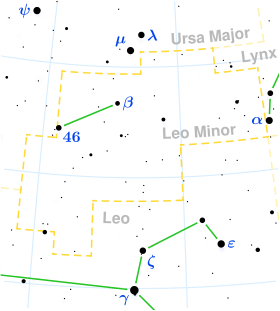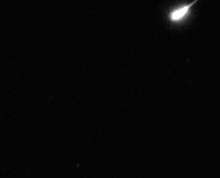Leonis Minorids
[1]Leonis Minorids [sic][1][2] (formerly Leo Minorids[3], IMO designation: LMI; IAU shower number: 22) is a weak meteor shower that takes place from October 19 till October 27 each year, peaking on October 23.[4] With a weak moon the meteor shower may be visible with the naked eye, however this meteor shower is best observed only from the Northern Hemisphere with telescopic plotting.[5] This meteor shower is linked to comet C/1739 K1 and radiates from the constellation Leo Minor, which is a faint constellation north of Leo.[6] The meteor shower often only produces 2 meteors an hour.[7] The meteors usually pass at an average speed of 62 kilometers per second.
| Year | Leonis Minorids active between | Peak of shower |
|---|---|---|
| 2008 | Oct 17 – 27 | October 24 (ZHRmax 2)[7] |
| 2009 | Oct 19 – 27 | October 23 predicted (ZHRmax 2)[6] |
| Leonis Minorids | |
|---|---|
 Celestial map of Leo Minor | |
| Parent body | Zanotti (C/1739 K1) |
| Radiant | |
| Constellation | Leo Minor |
| Right ascension | 10h 48m 0s |
| Declination | +37° 00′ 00″ |
| Properties | |
| Occurs during | October 19 to October 27 |
| Date of peak | October 24 |
| Velocity | 62 km/s |
| Zenithal hourly rate | 2 |
Notes
- "Established meteor showers". IAU Meteor Data Center. October 11, 2019. Retrieved January 12, 2020.
- McBeath, Alastair (2008). "2010 Meteor Shower Calendar" (pdf). IMO_INFO. International Meteor Organization. 2 (09): 12, 22 (tab. 5). Retrieved January 12, 2020.
- McBeath, Alastair (2006). "2007 Meteor Shower Calendar" (pdf). IMO_INFO. International Meteor Organization. 2 (06): 13, 26 (tab. 5). Retrieved January 12, 2020.
- "IMO Meteor Shower Calendar 2009: Contents: October to December: Leo Minorids". IMO.net. March 10, 2009.
- "IMO Meteor Shower Calendar 2009". The International Meteor Organization. 1997–2009. Retrieved October 22, 2009.
- "Leo Minorids fact sheet - Astronomia.org". Retrieved October 22, 2009.
- "In the Sky this Month – October 2008 – the Transient Sky – Comets, Asteroids, Meteors". the Transient Sky. Retrieved October 22, 2009.
gollark: No, it has the *origin* that.
gollark: Another update just now: I added timestamps, in the form of (I think?) milliseconds since the epoch.
gollark: Well, most recent 100, I mean.
gollark: Update right now: you can also run `skynet.logs(start, end)` to get a slice of the logs other than the default first 100 entries.
gollark: Skynet message logs are now public - update skynet and run `skynet.logs()` to get a table of objects containing {channel, message} plus metadata.
This article is issued from Wikipedia. The text is licensed under Creative Commons - Attribution - Sharealike. Additional terms may apply for the media files.
